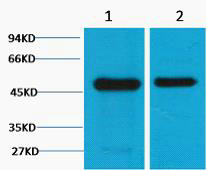产品名称
Flotillin-1(6C10)Mouse Monoclonal Antibody
别名
FN1; FN; Fibronectin; FN; Cold-insoluble globulin; CIG
存储缓冲液
PBS, pH 7.4, containing 0.5%BSA, 0.02% New type preservative N as Preservative and 50% Glycerol.
Human Gene Link
http://www.ncbi.nlm.nih.gov/sites/entrez?db=gene&term=2335
Human Swissprot No.
P02751
Human Swissprot Link
http://www.uniprot.org/uniprotkb/P02751/entry
Mouse Gene Link
http://www.ncbi.nlm.nih.gov/sites/entrez?db=gene&term=14268
Mouse Swissprot No.
P11276
Mouse Swissprot Link
http://www.uniprot.org/uniprot/P11276
Rat Swissprot Link
http://www.uniprot.org/uniprot/P04937
免疫原
Synthetic Peptide of Flotillin-1
特异性
The antibody detects endogenous Flotillin-1 protein.
背景介绍
This gene encodes fibronectin, a glycoprotein present in a soluble dimeric form in plasma, and in a dimeric or multimeric form at the cell surface and in extracellular matrix. The encoded preproprotein is proteolytically processed to generate the mature protein. Fibronectin is involved in cell adhesion and migration processes including embryogenesis, wound healing, blood coagulation, host defense, and metastasis. The gene has three regions subject to alternative splicing, with the potential to produce 20 different transcript variants, at least one of which encodes an isoform that undergoes proteolytic processing. The full-length nature of some variants has not been determined. [provided by RefSeq, Jan 2016],
组织表达
Expressed in the inner limiting membrane and around blood vessels in the retina (at protein level) (PubMed:29777959). Plasma FN (soluble dimeric form) is secreted by hepatocytes. Cellular FN (dimeric or cross-linked multimeric forms), made by fibroblasts, epithelial and other cell types, is deposited as fibrils in the extracellular matrix. Ugl-Y1, Ugl-Y2 and Ugl-Y3 are found in urine (PubMed:17614963).
细胞定位
Secreted, extracellular space, extracellular matrix .
信号通路
Focal adhesion;ECM-receptor interaction;Regulates Actin and Cytoskeleton;Pathways in cancer;Small cell lung cancer;
功能
alternative products:Additional isoforms seem to exist,developmental stage:Ugl-Y1, Ugl-Y2 and Ugl-Y3 are present in the urine from 0 to 17 years of age.,disease:Defects in FN1 are the cause of glomerulopathy with fibronectin deposits type 2 (GFND2) [MIM:601894]; also known as familial glomerular nephritis with fibronectin deposits or fibronectin glomerulopathy. GFND is a genetically heterogeneous autosomal dominant disorder characterized clinically by proteinuria, microscopic hematuria, and hypertension that leads to end-stage renal failure in the second to fifth decade of life.,function:Fibronectins bind cell surfaces and various compounds including collagen, fibrin, heparin, DNA, and actin. Fibronectins are involved in cell adhesion, cell motility, opsonization, wound healing, and maintenance of cell shape. Interaction with TNR mediates inhibition of cell adhesion and neurite outgrowth.,online information:Fibronectin entry,PTM:Forms covalent cross-links mediated by a transglutaminase, such as F13A or TGM2, between a glutamine and the epsilon-amino group of a lysine residue, forming homopolymers and heteropolymers (e.g. fibrinogen-fibronectin, collagen-fibronectin heteropolymers).,PTM:It is not known whether both or only one of Thr-2064 and Thr-2065 are/is glycosylated.,PTM:Sulfated.,similarity:Contains 12 fibronectin type-I domains.,similarity:Contains 16 fibronectin type-III domains.,similarity:Contains 2 fibronectin type-II domains.,subunit:Mostly heterodimers or multimers of alternatively spliced variants, connected by 2 disulfide bonds near the carboxyl ends; to a lesser extent homodimers. Interacts with FBLN1, AMBP, TNR, LGALS3BP and COL13A1. Interacts with FBLN7.,tissue specificity:Plasma FN (soluble dimeric form) is secreted by hepatocytes. Cellular FN (dimeric or cross-linked multimeric forms), made by fibroblasts, epithelial and other cell types, is deposited as fibrils in the extracellular matrix. Ugl-Y1, Ugl-Y2 and Ugl-Y3 are found in urine.,
纯化
The antibody was affinity-purified from mouse ascites by affinity-chromatography using specific immunogen.

